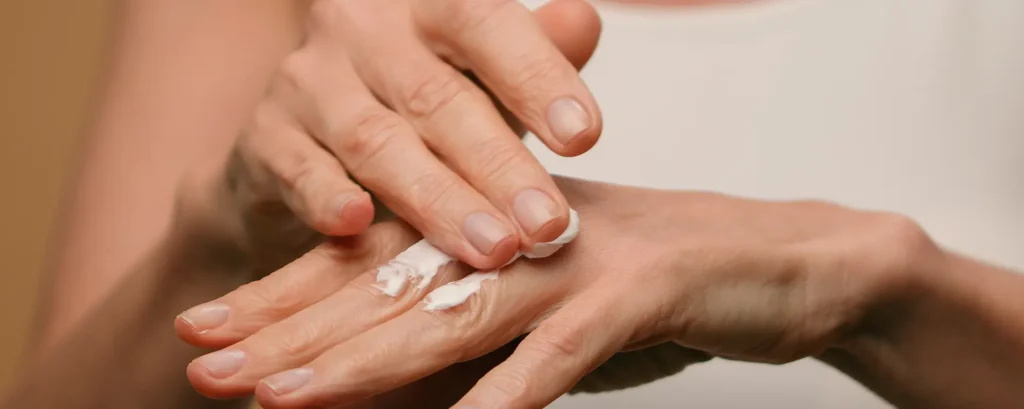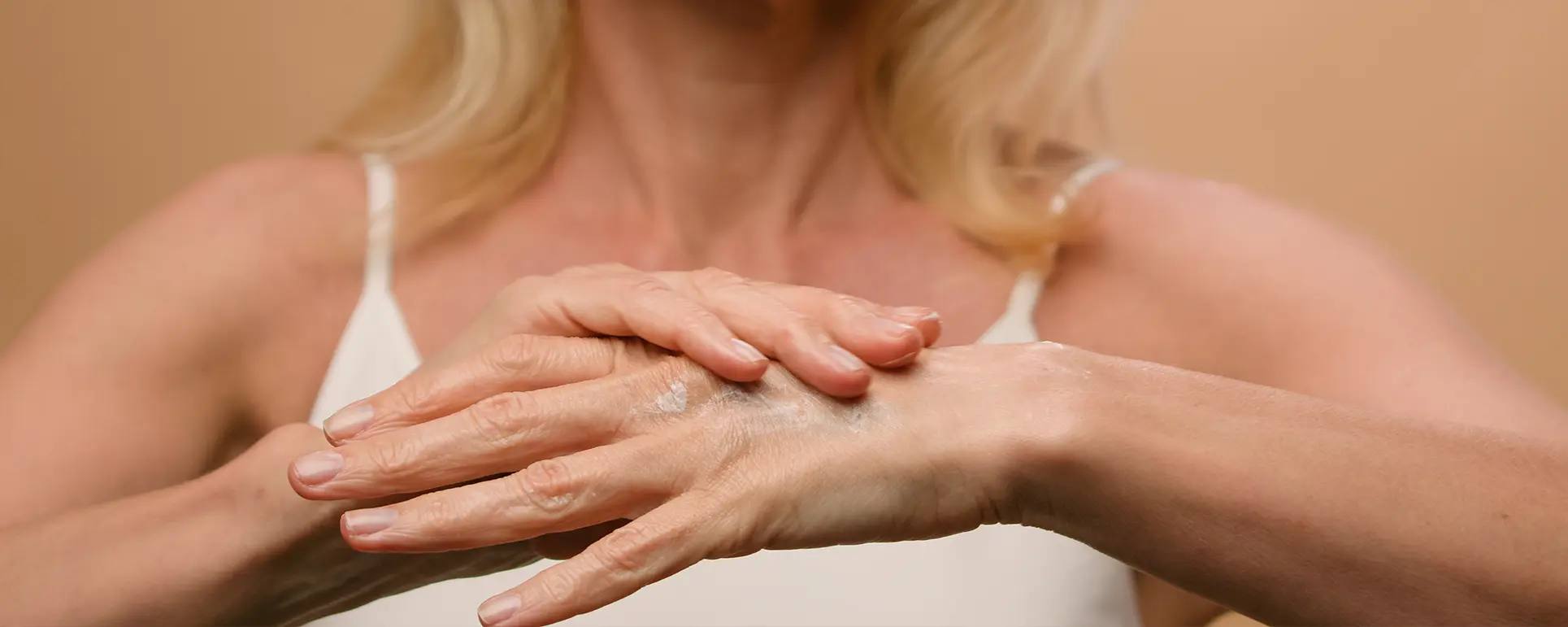It’s common to notice wrinkles, fine lines, age spots, and thinning skin on your hands well before your face begins to show the same signs of ageing. This happens because the skin on your hands is naturally thinner, has fewer oil glands, and produces less collagen compared to the skin on your face. Over time, this makes the hands more vulnerable to moisture loss and structural changes.
In addition, your hands are constantly exposed to environmental stressors such as sunlight, pollution, and harsh weather, which accelerate skin ageing through UV damage and free radical formation. Everyday activities like frequent washing, cleaning with chemicals, and repetitive movements strip away natural oils and compromise the skin’s protective barrier, leading to dryness, rough texture, and visible veins.
Unlike the face, which many people protect with sunscreen, moisturisers, and targeted skincare routines, hands often receive far less attention and protection. This neglect, combined with their high exposure, means signs of ageing can appear much sooner.
Another key reason is that the fat layer beneath the skin on the hands tends to thin out more quickly with age. This loss of volume makes veins, tendons, and bones more prominent, adding to the aged appearance. Over time, the reduced cushioning also makes the skin more prone to injury, bruising, and slower healing further contributing to an older look.
Dermatologists can explain these factors in detail and recommend treatments such as medical-grade moisturisers, chemical peels, laser therapy, dermal fillers, and daily sun protection to help restore a smoother, more youthful appearance to your hands. Taking preventive steps early like applying SPF to your hands, wearing gloves during chores, and using hydrating creams can significantly slow down the ageing process and keep your skin healthier for longer.
1. Why Hands Age Quickly

Sun exposure: Unlike the face, which many people protect daily with sunscreen or makeup containing SPF, the hands are often overlooked. This leaves them exposed to harmful ultraviolet (UV) rays year-round. Over time, this constant exposure can damage the skin’s DNA, leading to pigmentation changes, freckles, and stubborn age spots. Chronic sun damage also weakens collagen and elastin fibres, causing the skin to lose its firmness and develop fine lines more quickly.
Thinner skin: The skin on the backs of the hands is naturally thinner than that on the face or other parts of the body. It contains less subcutaneous fat, which acts as a natural cushion, and lower levels of collagen, the protein responsible for keeping skin plump and smooth. Because of this, even minor volume loss is more noticeable, and veins, tendons, and bones can become more prominent earlier in life.
Frequent washing & chemicals: Hands are constantly in contact with water, soaps, detergents, and hand sanitizers especially in the modern era of heightened hygiene awareness. While cleaning is essential, these substances can strip away the skin’s natural oils and disrupt its protective barrier. The result is dryness, flaking, and micro-cracking, which accelerate the appearance of wrinkles and texture changes.
Repetitive movements: Our hands are in near-constant motion throughout the day, performing countless tasks from typing and cooking to carrying bags and using mobile devices. These repetitive movements cause the skin to fold and crease in the same areas repeatedly, eventually leading to fine lines that become more pronounced with age. Combined with loss of skin elasticity, these movement-induced creases tend to deepen over time.
2. Daily Habits That Accelerate Hand Ageing
While genetics and natural ageing play a role, many seemingly harmless everyday habits can make your hands look older much sooner than they should. These actions often go unnoticed because the effects build up slowly, but over time, they weaken the skin’s structure, reduce elasticity, and cause visible ageing.
- Skipping sunscreen on hands: Applying sunscreen to your face while neglecting your hands is one of the most common mistakes people make. The skin on your hands is exposed almost constantly to direct sunlight during outdoor activities, while driving, and even from UV rays coming through windows. Without SPF protection, ultraviolet radiation penetrates deep into the skin, breaking down collagen and elastin, leading to sagging, wrinkles, and pigmentation. The damage is cumulative, meaning years of unprotected exposure will eventually show, even if you’re outside for just a few minutes each day.
- Overexposure to hot water or harsh soaps: Washing hands in very hot water or using strong, chemical-laden soaps strips away the skin’s natural oils. This not only causes dryness but also weakens the skin barrier, making it more prone to irritation, redness, and fine lines. For people who frequently wash dishes or clean without gloves, this damage can happen even faster. Over time, repeated exposure to these harsh elements accelerates ageing by leaving the skin constantly dehydrated.
- Neglecting moisturisation, especially after washing: Every wash removes moisture from your skin, and if you fail to replenish it with a nourishing hand cream or lotion, your skin becomes increasingly dry and fragile. Persistent dryness causes rough texture, small cracks, and creases that can deepen into permanent wrinkles. Applying a moisturiser immediately after washing can help lock in hydration and protect the skin barrier.
- Smoking or poor diet: Smoking causes blood vessels to constrict, reducing oxygen and nutrient delivery to skin cells. It also increases free radical production, which speeds up collagen breakdown. A poor diet especially one lacking in antioxidants, healthy fats, and vitamins like C and E further compromises skin health. Without proper nutrition, the skin loses resilience, heals more slowly, and shows signs of ageing earlier.
- Excessive use of alcohol-based hand sanitisers: While essential for hygiene, frequent use of high-alcohol sanitising gels can severely dehydrate the skin. Over time, this dryness can make fine lines more visible and the skin more fragile. Pairing sanitiser use with an immediate application of moisturiser can help counteract these effects.
- Ignoring protection during chores: Many household tasks, such as scrubbing floors, gardening, or using cleaning chemicals, expose your hands to friction, harsh substances, and water for extended periods. Without gloves, these repetitive exposures can speed up dryness, irritation, and thinning of the skin.
By becoming aware of these habits and making small adjustments such as applying SPF daily, switching to lukewarm water, using gentle cleansers, and wearing gloves during chores you can greatly slow down the ageing process and keep your hands looking smoother, softer, and more youthful for years to come.
3. Dermatology Treatments for Youthful Hands

When signs of ageing such as wrinkles, sun spots, thinning skin, and visible veins become noticeable, modern dermatology offers a wide range of solutions that can dramatically improve the appearance of your hands. These treatments not only enhance how your hands look but also improve skin health by stimulating collagen, boosting hydration, and protecting against future damage.
- Topical treatments: These are often the foundation of any hand rejuvenation plan. Dermatologists may recommend prescription-strength retinoids, which accelerate skin cell turnover, smooth fine lines, and boost collagen production. Antioxidants such as vitamin C, vitamin E, and ferulic acid can help neutralise free radicals, brighten dull skin, and reduce pigmentation caused by sun exposure. Advanced moisturisers containing hyaluronic acid, ceramides, or urea help lock in hydration, strengthen the skin barrier, and make the skin feel softer and plumper. When used daily and consistently, these treatments gradually restore a healthier, more youthful texture and tone.
- Chemical peels & laser therapy: Chemical peels use medical-grade acids (like glycolic, lactic, or trichloroacetic acid) to gently remove the top layers of damaged skin, revealing smoother, brighter skin beneath. They can help fade age spots, soften roughness, and even out skin tone. Laser treatments such as fractional CO₂ lasers, intense pulsed light (IPL), and Nd:YAG lasers go deeper, targeting pigmentation, broken capillaries, and collagen loss. Lasers also stimulate the skin’s natural repair processes, leading to firmer, fresher-looking skin over time. Depending on the intensity of the treatment, minimal to moderate downtime may be required.
- Dermal fillers: One of the most effective ways to instantly rejuvenate ageing hands is by restoring lost volume. Hyaluronic acid-based fillers are injected into the backs of the hands to plump up the skin, making veins and tendons less visible. The results are immediate, and most people enjoy smoother, fuller-looking hands for 6 to 18 months. Fillers also help improve hydration from within, as hyaluronic acid attracts and retains water in the skin.
- Microneedling & PRP (Platelet-Rich Plasma): Microneedling involves creating controlled microchannels in the skin to stimulate collagen and elastin production. When combined with PRP rich in natural growth factors derived from your own blood the treatment can accelerate healing, improve texture, and make the skin noticeably firmer. Over multiple sessions, this approach can soften fine lines, reduce pigmentation, and give hands a fresher, more even appearance with minimal downtime.
- Cryotherapy and targeted pigmentation removal: For stubborn dark spots caused by years of sun exposure, dermatologists may use cryotherapy to freeze and remove excess pigment, or targeted laser therapy to break down melanin in specific areas. These spot treatments work quickly and usually require little recovery time.
- Skin boosters & mesotherapy: In addition to fillers, skin boosters microinjections of hyaluronic acid, vitamins, and amino acids can deeply hydrate the skin and improve elasticity. Mesotherapy delivers a customised cocktail of nutrients directly into the skin to nourish and revitalise it from within.
Dermatologists often recommend a combination of these treatments for the most natural and long-lasting results. The choice depends on your skin’s current condition, your personal goals, and how much downtime you can manage. To maintain results, it’s essential to follow up with a consistent at-home routine that includes daily sunscreen, gentle cleansing, and regular moisturising. When done strategically, these treatments can make your hands look years younger while keeping them healthy and resilient.
4. Preventive Tips

While dermatology treatments can reverse many visible signs of ageing, prevention remains the most effective and cost-efficient strategy for keeping your hands youthful, healthy, and strong over the long term. By making small but consistent changes to your daily routine, you can protect the delicate skin on your hands from environmental damage, slow down collagen loss, and maintain softness and elasticity well into later life.
- Apply broad-spectrum sunscreen daily on hands: UV damage is the number one cause of premature skin ageing, yet hands are often overlooked when it comes to sun protection. Use a broad-spectrum sunscreen with SPF 30 or higher every morning, whether you’re spending the day outdoors or indoors. Harmful UV rays can penetrate glass, meaning driving, sitting near windows, or working in sunlit rooms can still expose your skin to damage. Keep a travel-sized sunscreen in your bag or car to reapply every 2–3 hours, especially after washing your hands.
- Use gentle soaps and follow with rich moisturisers: Cleansing is essential for hygiene, but harsh soaps, antibacterial cleansers, and hot water strip away the skin’s natural oils, leaving it dry and vulnerable. Opt for gentle, pH-balanced cleansers that clean effectively without damaging the skin barrier. After every wash, apply a nourishing hand cream with ingredients like shea butter, glycerin, ceramides, or hyaluronic acid. This immediate moisturising step prevents water loss, repairs micro-damage, and keeps skin soft and smooth.
- Wear gloves during cleaning, gardening, or outdoor activities: Household chores often expose your hands to chemicals, detergents, and prolonged water contact, which can irritate and weaken skin over time. Wearing rubber gloves while cleaning protects against harsh substances, while cotton liners inside the gloves can absorb sweat and prevent irritation. For gardening, wear protective gloves to avoid cuts, scrapes, and sun exposure. In cold or windy weather, insulated gloves protect against low humidity and windburn, which can cause chapping and cracking.
- Maintain a healthy lifestyle: External care is important, but the health of your skin also depends heavily on internal factors. Drink at least 6–8 glasses of water daily to maintain skin hydration. Eat a balanced diet rich in antioxidants (found in fruits, vegetables, nuts, and seeds), healthy fats (such as omega-3s from fish or flaxseed), and vitamins C and E, which are essential for collagen production and skin repair. Avoid smoking, as it reduces blood flow, depletes oxygen supply to skin cells, and accelerates the breakdown of collagen and elastin.
- Moisturise overnight for deeper hydration: Nighttime is the perfect opportunity to give your hands an intensive moisture treatment. Apply a thick, rich hand cream, balm, or ointment before bed to help repair and restore your skin’s protective barrier while you sleep. For an added boost, wear soft cotton gloves after applying your cream this locks in the moisture, prevents it from rubbing off, and allows the active ingredients to work more effectively.
- Be mindful of environmental conditions: Both hot and cold climates can be harsh on your skin. In hot, sunny weather, be diligent with sunscreen and hydration. In cold, dry conditions, use a humidifier indoors to prevent skin dehydration, and apply a heavier hand cream more frequently throughout the day.
- Limit excessive use of alcohol-based sanitisers: While hand sanitisers are important for hygiene, frequent use of high-alcohol formulas can dry out the skin significantly. If possible, choose sanitisers with added moisturising ingredients like aloe vera or glycerin, and follow up with hand cream immediately after use.
Incorporating these preventive strategies into your daily life not only keeps your hands looking youthful but also ensures they remain healthy, resilient, and protected against environmental stressors. Prevention is always easier and often far less expensive than correction, so starting these habits early can pay off for years to come.
Final Thought: Caring for Hands That Tell Your Story
Our hands often tell a story long before our faces do, silently showcasing the years of work, sun exposure, and daily routines they’ve endured. Unlike the face, which often receives regular moisturising, sun protection, and targeted treatments, the hands are frequently overlooked in skincare regimens. The combination of constant movement, exposure to environmental stressors, frequent washing, and the natural decline in collagen and elastin means that signs of ageing such as wrinkles, pigmentation, and thinning skin can appear here first. Recognising this difference is the first step toward giving your hands the same attention and care you devote to your facial skin.
Hand ageing is a natural process, but it is far from irreversible. With consistent protective habits like applying broad-spectrum sunscreen daily, using gentle cleansers, and replenishing moisture regularly combined with modern dermatological treatments, you can restore volume, improve texture, and reduce pigmentation. Chemical peels, laser therapies, dermal fillers, and collagen-stimulating procedures all offer effective options for revitalising the hands.
Hand ageing is a natural process, but proactive care and professional treatments can make a visible difference. You can get in touch with us to book a consultation with one of our expert dermatologists in London for personalised advice and rejuvenation options.
References:
- Farinelli, W., 2022. Revitalizing Hands: A Comprehensive Review of Anatomy and Physiology and Rejuvenation Techniques. Journal of Cosmetic Dermatology, [online] Available at: https://pmc.ncbi.nlm.nih.gov/articles/PMC10063163/
- Dobos, K., 2025. The Flip Sides of Hand Skin Aging: How Dorsal Differences Present a Novel Market Opportunity. Cosmetics & Toiletries, [online] Available at: https://www.cosmeticsandtoiletries.com/research/literature-data/article/22937933/the-flip-sides-of-hand-skin-aging-how-dorsal-differences-present-a-novel-market-opportunity
Peters, H., Smith, J. and Lee, K., 2021. Defining skin aging and its risk factors: a systematic review and meta-analysis. Scientific Reports, 11, Article number: 2853. https://doi.org/10.1038/s41598-021-01573-z
